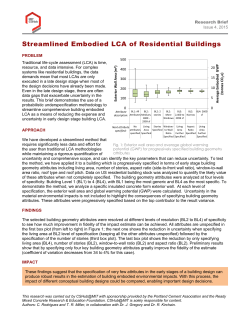
CIBSEFeb15 pp36
THE FACTS OF LIFE A new tool will enable software designers to embed Life Cycle Assessments data and costs in a BIM model. Andrew Cooper and Daniel Doran report on how Impact could help save money and cut embodied carbon T Embodied carbon from the production and transport of construction materials is all upfront, contributing towards global warming before the building is opened European standards The European Standards body, CEN, has produced a number of standards addressing sustainability of buildings and life cycle assessment, through Technical Committee 350. See http://bit.ly/1JsejBh for further background, and http://bit. ly/1CJcspn for an overview of the standards. help from CIBSE CIBSE has recently published TM56 Resource efficiency of building services, which looks at the issue of embodied energy in buildings, and summarises the tools currently available. 36 CIBSE Journal February 2015 he need for more housing and commercial space will make it very difficult for the UK to reduce its carbon emissions in line with targets under the Climate Change Act 2008. This is partly because government and the building sector has largely ignored the issue of embodied carbon. The reasons for this were put eloquently by Guy Battle, of the Sustainable Business Partnership, in the August 2014 edition of CIBSE Journal. He pointed out the difficulties of measuring embodied carbon and obtaining transparent, comparable data. However, 10% of all UK emissions are associated with the manufacture and transport of construction materials. To appreciate how significant this figure is, it is worth considering that the operation of all UK buildings currently accounts for around 40% of emissions. The construction of new homes in 2013 made up 0.5% of total housing stock, while new commercial buildings amounted to about 1% over the same period. That means, at a growth or replacement rate of only about 1.5%, new buildings and refurbishments are already accounting for 10% of all emissions. Governments of all colours are committed to increase the rate of building, so this figure is likely to grow. This ‘imbalance’ occurs because embodied carbon from the production and transport of construction materials is all upfront, contributing towards global warming even before the building is opened. To help reduce energy consumption and emissions, and improve energy security, the government has, among other things, introduced the Energy Act 2011 and minimum energy performance standards (MEPS), which are due to come into force by 2018. Research by CO2 Estates suggests that industry will need to spend £29bn on energyconservation measures to meet these new standards, resulting in a saving of almost 18m tonnes of CO2 per year from the operation of buildings. However, by the time we factor in increases in emissions as a result of embodied carbon, we do not know what the impact of this spending will be in terms of the net gain or reduction of emissions, and over what period. These emissions from increased construction are contributing to climate change right away, whereas operational emissions are released gradually, over the life of the building. The climate-change effect of upfront emissions will be worse than gradual ones, even if the total is the same. Consider the urgency involved in reducing greenhouse gas emissions. Put that alongside the rate of building globally, as the world’s population increases, and as the economic fortunes of developing countries improve. It is simply not possible to ignore the issue of embodied carbon and achieve wider emissionreduction targets. Some might say the writing is on the wall, and that we need to undertake routinely a life cycle assessment (LCA) before any construction or major refurbishment. If that www.cibsejournal.com Software Life cycle assessment tool obtaining credits for BREEAM or LEED. It is generally undertaken by niche consultants and academia, and, as a result, the fees can be high. Simple economics dictates that – if fees are high and the assessments are not mandatory – developers will not do an LCA where more cost-effective options are available. However, a new tool has been developed to make these measurements more affordable. is the case, engineers of all disciplines will need to consider the environmental impact of materials as part of the procurement process. This is why CIBSE and WRAP collaborated on TM56 Resource Efficiency of Building Service, which was launched in December 2014. This explores the impacts of building services in terms of manufacturing, construction, maintenance and disposing of the equipment at end of life There are already tools and data sets available to do LCAs. This work is often part of a wider benchmarking exercise, such as PVC pipes and straw differ in their embodied energy MILA Zed / Shutterstock Enter Impact Impact has been developed as part of a three-year project, funded by the Technology Strategy Board (TSB) and involving BRE and Willmott Dixon methodologies, IES software and AEC3. It is a specification and database for software developers to incorporate into their tools, to enable consistent LCA and Life Cycle Costing (LCC). Open to all suitable software developers, Impact allows users to attribute environmental and cost information to drawn or scheduled items in a Building Information Model (BIM). Put simply, it takes quantity information from the BIM and multiplies this by environmental impact and/or cost ‘rates’, to produce an overall impact and cost for the whole – or selected part – of a design. The aim is to integrate LCA, LCC and BIM. By making Impact – and, in particular, the BRE database on environmental impacts – more widely available, the reasons for not having an LCA measurement, as highlighted by Battle, are likely to be removed or reduced. The use of Impact should reduce the cost of assessments, and encourage its take-up; BRE is offering additional BREEAM credits – under the Material 1 scoring – where Impact has been used. An initial review suggests that the tool will also satisfy the current whole-building LCA requirements of LEED. The LCA of building services It is widely accepted that building services are an important source of embodied impacts from construction. To understand the overall life-cycle consequences of a building, it is important to include building services when carrying out an LCA. For example, if a project team opts for natural ventilation and minimising artificial lighting, this will typically require a narrower floor plate. This, in turn, will often affect the ratio of floor space to envelope, potentially resulting in more materials being used in the construction of external walls and other parts of the building fabric. This will, typically, result in higher embodied impacts. However, the increase may be offset by the reduction in embodied impacts from building www.cibsejournal.com services – achieved through the significantly fewer components specified in naturally ventilated buildings, not to mention reductions in operational energy. As such, a net benefit can be demonstrated for the building. Unfortunately, if building services are not included in the LCA, the potential net benefit cannot be demonstrated, and the natural ventilation-based design may appear worse. To carry out a building LCA, background data – known as environmental product declarations (EPD) – are required for each of the products/systems specified. To make informed comparisons, EPD are required not only for the products/systems specified, but also for any alternatives considered during the design process. This implies that a comprehensive resource of comparable EPD for all products/systems typically specified is required. Moreover, the resource needs to be in a format that is useful to building designers. In the UK, this has existed for some time for building fabric, in the shape of BRE’s Green Guide – and, more recently, Impact tools – but none exists for building services. Unfortunately, this lack of data may lead some building LCAs to rely on assumptions about the constituent materials within the various components/systems. Results derived from this kind of approach are likely to be subject to a high degree of uncertainty. Many components – for example, fan coil units, chillers, boilers, valves, AHUs, luminaires, comms and fire devices – are complex, and highly engineered from a wide range of substances using intensive techniques. They are also sourced from a complex international supply chain. Without intimate production knowledge, it is very difficult to make estimates with an acceptable level of certainty. As such, results derived from these methods should be used with caution. Poor-quality data will still yield results – the consequences of which may not be apparent to those who are not expert in LCA – and this could delay the realisation, by the industry, of the need for good-quality data. Until a robust source of building services LCA data/EPD is available, BRE believes it is preferable to exclude services from building LCAs. To resolve this issue, BRE is open to partnering with manufacturers and designers to produce a data set – and it hopes this can be realised in the near future. CJ l Andrew Cooper is an independent property and energy consultant l Daniel Doran is a senior consultant at BRE, leading for the Impact project February 2015 CIBSE Journal 37
© Copyright 2025





















